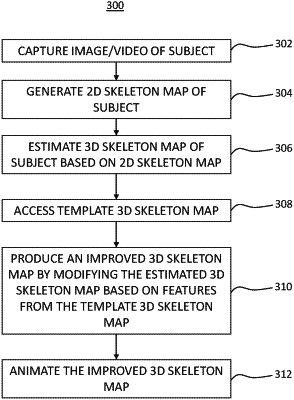| CPC G06T 13/40 (2013.01) [G06T 7/70 (2017.01); G06T 7/251 (2017.01); G06T 17/00 (2013.01); G06T 2207/10024 (2013.01); G06T 2207/20081 (2013.01); G06T 2207/20084 (2013.01); G06T 2207/30196 (2013.01)] | 25 Claims |

|
1. A system to generate a 3D pose of a subject, the system comprising:
memory;
instructions; and
one or more processor circuits to be programmed by the instructions to:
access one or more images of the subject from an image capturing device;
produce a two-dimensional (2D) skeleton map associated with the subject in the one or more images, the 2D skeleton map including a plurality of 2D joint locations;
produce an estimated three-dimensional (3D) skeleton map associated with the subject in the one or more images based at least on the plurality of 2D joint locations, the estimated 3D skeleton map including a plurality of 3D joint locations and a plurality of bone segments between corresponding pairs of 3D joint locations;
produce an improved 3D skeleton map by at least retargeting a corresponding length of one or more of the plurality of bone segments of the estimated 3D skeleton map to more closely match a corresponding length of one or more corresponding template bone segments of a template 3D skeleton map, the template 3D skeleton map having a plurality of template 3D joint locations and a plurality of template bone segments between corresponding pairs of template 3D joint locations;
animate the improved 3D skeleton map based on corresponding movement of the subject;
produce a second 2D skeleton map associated with a second subject in the one or more images, the second 2D skeleton map including a second plurality of 2D joint locations;
produce a second estimated 3D skeleton map associated with the second subject in the one or more images based at least on the second plurality of 2D joint locations, the second estimated 3D skeleton map including a second plurality of 3D joint locations and a second plurality of bone segments between corresponding pairs of second 3D joint locations;
produce a second improved 3D skeleton map by at least retargeting a corresponding length of one or more of the second plurality of bone segments of the second estimated 3D skeleton map to more closely match a corresponding length of one or more corresponding second template bone segments of a second template 3D skeleton map, the second template 3D skeleton map having a second plurality of template 3D joint locations and a second plurality of template bone segments between corresponding pairs of second template 3D joint locations; and
animate the second improved 3D skeleton map based on corresponding movement of the second subject.
|